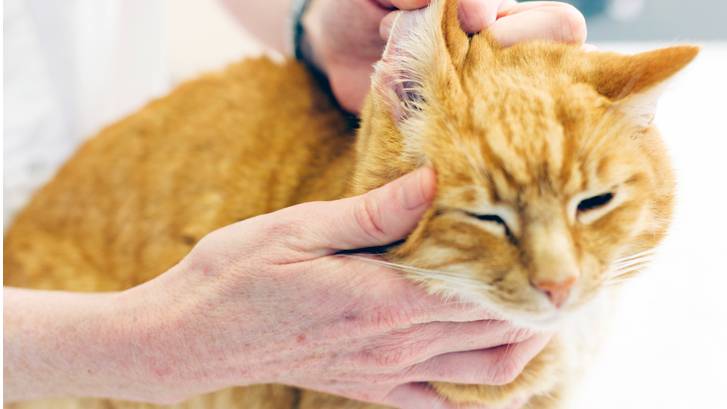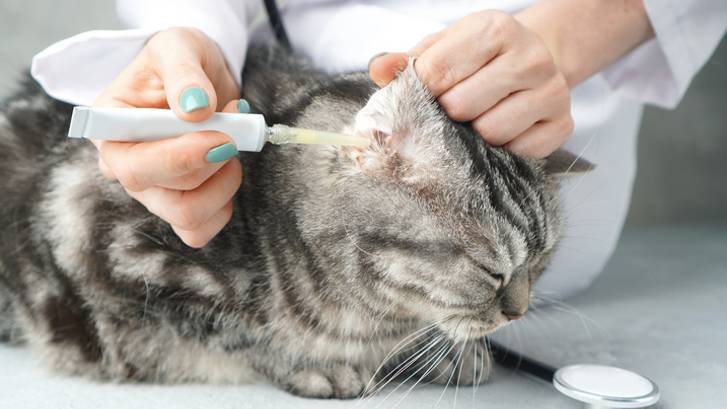Ear infections in cats: Vet's guide to causes and treatment
Ear infections in cats can have a number of underlying causes, read on to find out more

One of the conditions that vets often diagnose is ear infections in cats. Although dogs most commonly tend to have ear and skin problems, one study from the Journal of Feline Medicine and Surgery showed that in a population of stray cats, an ear infection (otitis externa) was present in 55.1%.
It’s therefore important to know what the signs of infection are as well as the possible causes and treatments. If you are worried that your cat is uncomfortable then you should always get them checked out by a veterinarian who might be able to confirm your suspicions.
- Ear infections in dogs: Vet's guide to causes and treatment
- Common allergies in cats: 4 things you can do about them
Symptoms of ear infections in cats
The following symptoms are often seen in cats with ear infections:
- Increased wax or discharge in the ear canal
- An increased odor from the ears, which might be unpleasant
- Your cat is scratching excessively at his ears and face
- Inflamed skin or scabs in and around the ears
- Excessive head shaking
- Swelling of the ear flap (aural hematoma)
In severe cases where the inner ear is affected these additional signs might be seen:
- Tilting their head on one side
- Loss of balance
- Eyes flicking from side to side (nystagmus)

Causes of ear infections in cats
There are several possible underlying causes for ear infections in cats. Usually, these are conditions that cause inflammation in the sensitive ear canal leading to secondary bacterial or yeast infections:
Ear mites
Parasites such as ear mites can cause your cat problems with their ears. The most common ear mite, Otodectes cynotis, is barely visible to the naked eye but may be seen as small white dots when your vet is examining your cat’s ears with an otoscope.
They can be seen more clearly under a microscope. These mites cause inflammation and secondary infections, as well as being quite itchy.
Get the best advice, tips and top tech for your beloved Pets
Skin allergies
Underlying skin allergies can make your cat more prone to developing ear infections. Cats can be allergic to any number of things including flea bites, grass pollens, tree pollens, house dust mites, food, and other animals. An allergic flare-up can cause inflammation of the skin, including the ear canal, leaving it more prone to secondary growth from bacteria or yeasts.
Growths in the ear canals
Tumours or benign polyps in the ear canal can cause inflammation leading to secondary infections occurring. Masses could potentially be malignant such as ceruminous gland adenocarcinomas. The mass could also obstruct the ear canal causing discomfort and making the ear canal more moist and warm — a perfect environment for yeasts and bacteria to cause damage.
Foreign bodies
Something lodged or trapped in the ear canal can cause issues leading to infection. One of the most common foreign bodies is grass seeds or awns. Their spikey ends become stuck in the canal causing extreme irritation.
Idiopathic
Infections can sometimes occur without an underlying trigger. Most bacterial and yeast infections are secondary to one of the above scenarios but occasionally they can occur with no obvious predisposing cause. We call this ‘idiopathic’ ear disease.

Treatment for ear infections in cats
Treatment may depend on the cause of your cat's ear infection. Your veterinarian will start by examining your cat, usually using a tool called an otoscope to look down their ear canals. Depending on what they see they might suggest sedating or anesthetizing your cat (for retrieval of a foreign body or to take biopsy samples from a mass for example).
Alternatively, they might suggest taking samples of wax to look at under the microscope or sending them away to the laboratory to culture and identify bacteria. This way they can differentiate between a cat ear infection and ear mites.
Treatment may involve topical ear drops and ear cleaners to treat the infection, and possibly separate anti-inflammatory medications to make your pet more comfortable. Surgery may be needed in some cases if tumors or polyps are present, or if the ear infection is severe. Anti-parasite treatment will be helpful in cases of ear mites, and allergy investigations may be advised for those with suspected skin allergies.
Can a cat's ear infection go away on its own?
Ear infections don’t usually go away on their own, treatment such as antibiotics is required to tackle the infection. The underlying trigger for the ear infection may need resolving too, such as ear mites, a foreign body, or a growth.
How do you treat a cat ear infection that won't go away?
You must see your veterinarian if your cat has an ear infection that is not resolving. Over-the-counter products or ear drops bought off the internet are not usually effective. Your vet will examine your pet and help make a more effective treatment plan for your pet.
Is a cat ear infection an emergency?
In most cases, an ear infection is not a true emergency. Although your cat should see a veterinarian soon, it can wait until your hospital's next available appointment during normal clinic hours. The exception would be if your cat has suddenly lost their balance or has a head tilt, which could indicate a more serious inner ear problem.

Preventing ear infections in cats
Checking your cat's ears regularly yourself can help you to spot any early signs or problems. It’s hard to prevent infections and issues from occurring in the first place, but you can stop things from getting worse by getting your pet seen quickly. Don’t purchase products from pet stores and the internet as these are rarely helpful, and usually just delay your cat getting appropriate veterinary treatment.
Conclusion
Ear infections in cats can be caused by various underlying triggers, which can then be made worse by secondary bacterial or yeast infections. If your cat is showing signs of discomfort with their ears then get them checked out by a vet, so that they can receive appropriate treatment.
Rebecca is a veterinary surgeon who graduated from the Royal Veterinary College in London in 2009. She enjoys medicine in particular and she is proud to have achieved a BSAVA postgraduate certificate in small animal medicine (with commendation) from Nottingham Trent University in 2021.
She has a wealth of experience in first opinion small animal practice, having done a mixture of day-to-day routine work, on-call emergency duties and managerial roles since 2009.
She writes on various feline and canine topics for the Veterinary Content Company and a freelance basis, including behavior, nutrition, and health. Outside of work and writing she enjoys walking her own dog, spending time with her young family and baking!

